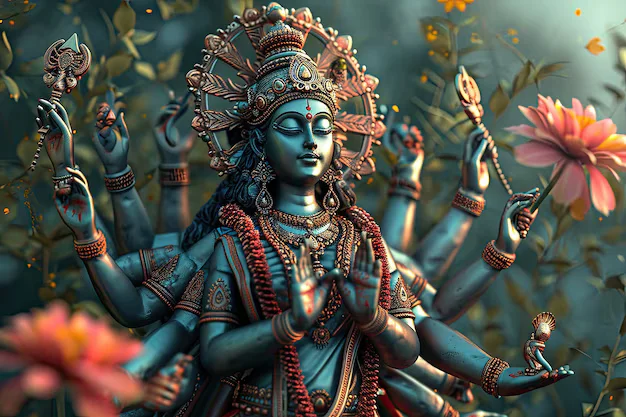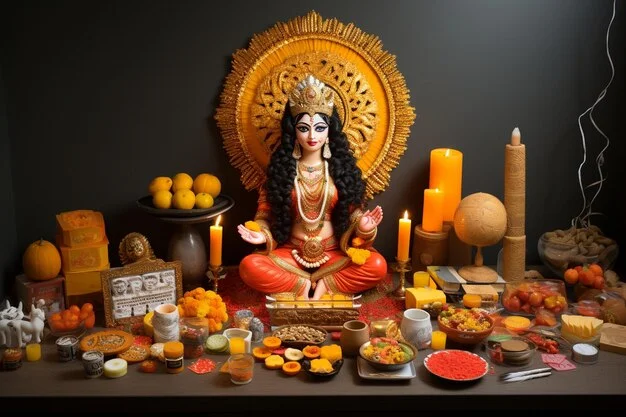Introduction
Navratri is one of the most widely celebrated festivals in Hindu culture, observed with great enthusiasm across India and beyond. Derived from the Sanskrit words “Nava” (meaning nine) and “Ratri” (meaning night), this nine-day festival honors the divine feminine energy, or Shakti, in her various forms. For many, Navratri is not only a time for vibrant festivities but also a period of intense spiritual reflection and personal growth.
The festival’s importance lies in its dual nature: it celebrates both the physical—through music, dance, and fasting—and the spiritual—through meditation, prayer, and devotion to the Goddess. Understanding Navratri allows us to connect deeply with the traditions, values, and significance behind each day of the celebration.
What is Navratri?
Definition and Etymology
“Navratri” translates to “nine nights.” During these nine nights and ten days, people worship different forms of the Goddess Durga, the embodiment of strength, protection, and benevolence. Each day of Navratri is dedicated to a different form of the Goddess, signifying various aspects of life and spirituality. The festival’s roots go back thousands of years, and its message is timeless—representing the victory of good over evil.
Also Read- Diverse Holi Celebrations Across India: A Festival of Colors and Traditions
The Divine Feminine Energy
Navratri is closely associated with Shakti, the primal feminine force that is believed to sustain the universe. This divine energy takes many forms, and during Navratri, devotees honor these forms through rituals, prayers, and fasting. This connection to the divine feminine helps to balance energies within oneself, fostering qualities like strength, wisdom, and compassion.
The 9 Days of Navratri: Daily Significance
One of the unique aspects of Navratri is the focus on the nine forms of Goddess Durga, with each day symbolizing a different manifestation of her power and qualities. These nine days not only mark the victory of the goddess over the demon Mahishasura but also signify various virtues that one can integrate into one’s life.
-
Day 1: Shailaputri – Strength and Stability
On the first day, devotees worship Shailaputri, the daughter of the mountains. She symbolizes strength, stability, and the power to endure. Her story reminds us of the importance of being grounded, especially in difficult situations. Meditating on Shailaputri helps cultivate a sense of inner strength and resilience.
-
Day 2: Brahmacharini – Purity and Discipline
The second day is dedicated to Brahmacharini, who embodies purity, discipline, and devotion. She is a reminder of the significance of perseverance on the spiritual path. Her example encourages us to embrace discipline and simplicity, values that are essential for personal and spiritual growth.
-
Day 3: Chandraghanta – Beauty and Charm
On the third day, Chandraghanta is honored. She represents beauty, charm, and grace. She teaches us that outward strength should be balanced with inner grace and poise. Her bell-shaped moon adorns her forehead, symbolizing inner peace that comes from overcoming life’s battles.
-
Day 4: Kushmanda – Vitality and Energy
Kushmanda, the goddess of creation, is worshiped on the fourth day. She signifies vitality, energy, and the life force that sustains the universe. Her worship instills in devotees a renewed sense of purpose and vitality, urging us to foster a positive mindset and create something meaningful in our lives.
-
Day 5: Skandamata – Wisdom and Knowledge
On the fifth day, devotees worship Skandamata, the mother of Skanda (Kartikeya), who is associated with wisdom and protection. She represents the nurturing aspect of wisdom and the importance of caring for our intellectual and spiritual development. Her worship encourages us to seek knowledge, both worldly and spiritual.
-
Day 6: Katyayani – Courage and Intuition
Katyayani, revered on the sixth day, is the warrior goddess who symbolizes courage, intuition, and righteous action. She is the embodiment of fierce protection and determination, teaching us to stand up for what is right. Her worship reminds us of the importance of acting with courage in the face of adversity.
-
Day 7: Kaalratri – Power and Protection
The seventh day is dedicated to Kaalratri, the fiercest form of Durga. She signifies the power to destroy negativity and protect the righteous. Worshiping her invokes the strength to remove darkness and fear from our lives. Kaalratri reminds us of the importance of facing our fears head-on and eliminating negative influences.
-
Day 8: MahaGauri – Purity and Enlightenment
On the eighth day, MahaGauri is honored. She represents purity, tranquility, and the cleansing of the soul. Her radiance is said to purify the minds of her devotees and lead them toward a higher state of enlightenment. This day emphasizes inner purification and spiritual clarity.
-
Day 9: Siddhidatri – Perfection and Accomplishment
The final day of Navratri is dedicated to Siddhidatri, the goddess of supernatural powers (siddhis) and accomplishments. She represents the fulfillment of spiritual desires and perfection in every aspect of life. Her blessings enable devotees to achieve their goals and realize their true potential.
Why is Navratri Celebrated?

Historical Context: The Legend of Durga and Mahishasura
Navratri is celebrated to honor the victory of Goddess Durga over the demon Mahishasura. According to legend, Mahishasura, a demon with the ability to shape-shift, was terrorizing the world. The gods, unable to defeat him, invoked Durga, who battled him for nine days and nights, finally defeating him on the tenth day. This victory represents the triumph of good over evil and is commemorated every year during Navratri.
Symbolism of Good vs. Evil
Navratri serves as a reminder of the eternal battle between good and evil, not just in the world but within ourselves. The festival encourages us to conquer our inner demons—such as ignorance, arrogance, and fear—through self-discipline, courage, and devotion.
Focus on Personal and Spiritual Growth
Navratri is not only a time for celebration but also an opportunity for personal and spiritual growth. The fasting, prayers, and rituals performed during these nine days help purify the mind and body, promoting a deeper connection with the divine. Many people take this time to reflect on their actions and make positive changes in their lives.
The Spiritual Practices of Navratri
Why is Fasting Important During Navratri?
One of the central spiritual practices during Navratri is fasting. Fasting is believed to purify both the body and mind, allowing devotees to focus better on spiritual practices. During this period, many abstain from grains and meat, opting for light, sattvic foods, which are considered pure and energy-enhancing. Fasting helps in detoxifying the body and heightens spiritual awareness.
Role of Meditation and Prayer
In addition to fasting, meditation and prayer are integral parts of Navratri. This is a time when many focus inward, engaging in spiritual practices like chanting mantras and performing pujas (rituals). These practices deepen one’s connection with the divine and bring peace and clarity to the mind.
Cultural Celebrations of Navratri
Navratri is not just a spiritual event but also a vibrant cultural celebration. Different regions of India celebrate it in unique ways, and these variations add richness to the festival.
- In Gujarat, the festival is marked by the energetic dance forms of Garba and Dandiya, where people gather in large numbers to dance around a decorated altar.
- In South India, Golu is a popular tradition where families set up elaborate displays of dolls that depict mythological stories.
- In West Bengal, Durga Puja is celebrated with grand pandals, music, and offerings to the Goddess Durga, culminating in her immersion in water.
These regional differences emphasize the significance of community and family gatherings, and how cultural practices enrich the Navratri experience.
Astrological Significance of Navratri
In addition to spiritual and cultural significance, Navratri is believed to have an astrological influence. Each of the nine days is linked to specific planetary energies, and the rituals performed during Navratri are said to align individuals with these cosmic forces. By worshiping the goddesses and following the rituals, devotees can harness these energies for personal growth, success, and harmony.
Conclusion
Navratri is more than just a religious festival; it is a celebration of life, strength, and spiritual awakening. Each of the nine days offers a unique opportunity for reflection, personal growth, and a deeper connection with the divine. Whether you participate in fasting, prayers, or vibrant cultural events, Navratri reminds us of the importance of balance—between strength and compassion, action and reflection.
So, this Navratri, take a moment to immerse yourself in the festival, honor the goddess within, and embrace the virtues that each day represents.
9. FAQs About Navratri
Q: What are the main customs of Navratri?
A: The primary customs of Navratri include fasting, praying to different forms of Goddess Durga, performing rituals, and participating in cultural activities like Garba and Dandiya.
Q: Why do people fast during Navratri?
A: Fasting during Navratri is seen as a way to purify the body and mind, allowing devotees to focus more on spiritual practices and connect with the divine.
Q: What is the story behind Navratri?
A: Navratri celebrates the victory of Goddess Durga over the demon Mahishasura, symbolizing the triumph of good over evil.


[…] Navratri celebrations are a true reflection of the country’s cultural diversity, where tradition and modernity […]